The Best New York Style Pizza Dough and 14 Tips for Success!!
I’ve been making a lot of this NY style pizza dough recipe …. The obsession started a while back, and I’ve finally found a recipe that I love the best! After years of experiments (and I mean years!), I am now using this recipe based on recommendations from the many fine pizza makers at www.pizzamaking.com and the late great Dough Doctor, Tom Lehmann.

Making Pizza Dough at Home
Making NY style pizza dough is definitely somewhat of an art form. There are so many variables that can be changed aside from the ingredients alone. For example, these variables include:
- oven temperature
- temperature of the water used to make the dough
- proofing methods (room temp vs cold rise)
- order of adding the ingredients (yes, this makes a big difference!)
- mixing time
- use of autolyse
- use of poolish (I don’t do this or the one before, although I have in the past)
And then of course, the toppings which can be simple or as complex as you’d like. But don’t worry too much about all of this – my method is easy and straightforward. Plus, you will make better dough than 99% of the pizza chains out there. You will not want take out anymore!
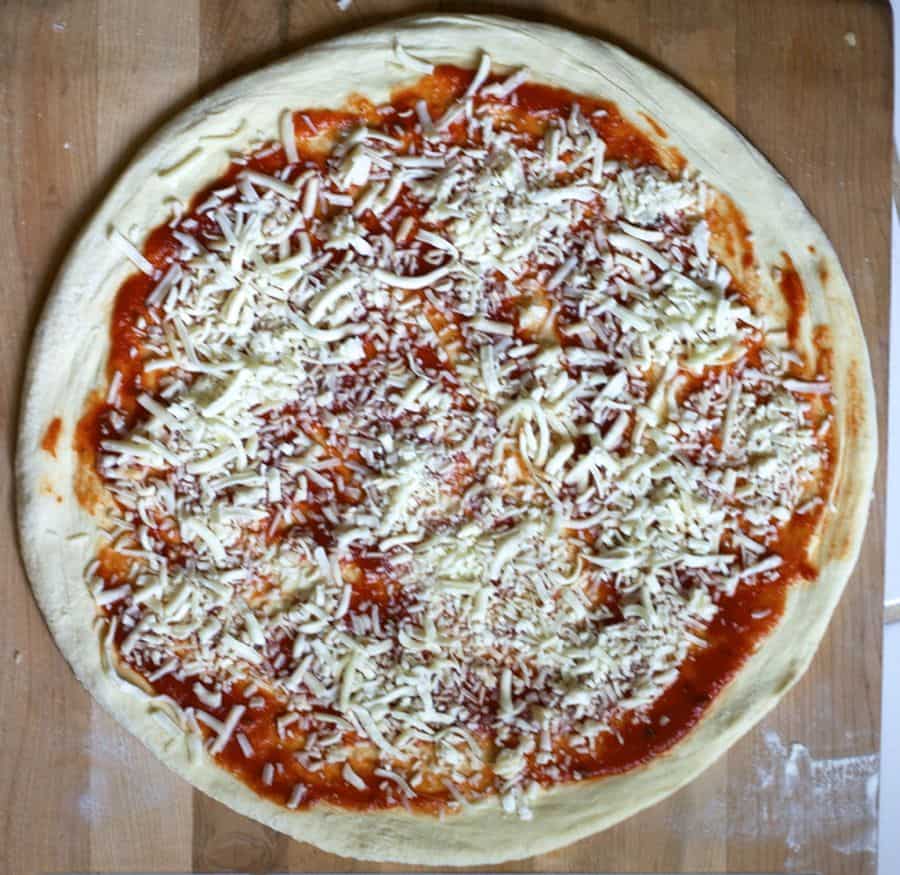
My Favorite Pizza Dough: The Big Secret (How You Proof the Dough)
My all-time favorite dough is NY style dough, which really is classic pizza dough that is stretched out into a thin crust pizza. This type of pizza dough contains water, flour, salt, instant yeast, and olive oil (and sugar especially when baking in a home oven, to help browning).
After it is mixed, it is proofed (left to rise/ferment) in the refrigerator for a minimum of 24 hours and up to 72 hours (it can also be frozen) – this is the big secret. I’ve used the dough up to 5 or 6 days afterwards, so you can essentially prepare dough for the week.
This recipe produces a crisp yet foldable crust that is tender, light, and flavorful and will make enough for four 14-inch pizzas. You can easily double or half the recipe to make 2 or 8 pizzas.

Fourteen Tips for Success
Tip 1: Choosing the flour
Use high-quality flour – I like to use King Arthur’s all purpose or bread flour; higher protein (ie, bread) flours work best. However, I prefer all-purpose flour because I like a lighter, airy crust.
Tip 2: Adding the yeast
Do not add instant dry yeast (IDY) directly to cold or cool water – you may shock the yeast (add the IDY to your flour instead) (please note that IDY differs from active dry yeast, which must be activated by adding it to water).
Tip 3: How much yeast?
Use only enough yeast to “get the job done” – yeast eats the sugar in your flour to produce its leavening effects – I find that if you use too much, your dough will be tasteless (this is just my opinion); however, it is a fact, that too much yeast can make your dough taste bad. Most recipes out there, some of them in well known, published books contain too much yeast!
Tip 4: Cold ferment that pizza dough!
Always use your refrigerator. The best NY style doughs “ferment” or “cure” in the refrigerator for at least 24 hours and up to 48 72 hours. This is called a “cold rise” (vs warm rise on your kitchen counter).
The refrigerator is used to retard (or slow) the dough’s fermentation, allowing that distinctive flavor to come through (ever wonder why some pizza crust tastes different than others, despite the fact that they are both made from just about the same exact ingredients? – this is a big reason why!)
When your dough rises too quickly, the flavor will not develop optimally. Slow rise = MUCH better flavor.
Tip 5: Weigh those ingredients!
Use a scale to weigh the flour instead of using a measuring cup – it is much more accurate and will yield superior results. I’ll admit, I resisted doing this for a loooong time. Just do it. You’ll be glad you did and your dough will be more consistent and much improved.
Tip 6: Add oil last
Mix the oil in as the last step, after the flour has all been incorporated. This is important to allow the flour to hydrate properly.
Tip 7: Flour your dough balls
Before tossing or opening your dough balls, flour them *very* well on each side (if you are a beginner) to ensure they do not stick to your counter or pizza peel. I sometimes use a bit more flour after I begin spreading them.
Tip 8: Keeping those rims a bit puffy
Take care not to “degas” the rim of your pizza as you are spreading your dough! Do NOT ever use a rolling pin! There are many different methods to spread/open your dough ball. I hope to add a few pictures someday of this process.
Tip 9: Baking pizza in a home oven
Ensure that your oven is preheated for a sufficient amount of time (about 1 hour) and bake the pizza within 6 to 8 inches of the top of your oven (ie, your broiler) so that the tops browns sufficiently in conjunction with the bottom of the pizza.
Do not place the stone near the bottom of your oven. I made this mistake for too many years.
After your stone has been preheated sufficiently, the heat from the stone will cook the pizza from the bottom and you can switch the broiler on if you find you need more browning on the top (I now use the broiler to bake my pizzas…more on this sometime in the future).
If you find that your cheese is browning well before your rim attains sufficient color, use partially frozen cheese (ie, place shredded cheese in the freezer while the oven is heating up) and cold sauce or you can drizzle just a bit of olive oil on top of cheese.
Tip 10: Use a pizza stone or steel
Use a pizza stone if you have one. The stone with draw moisture out of the dough and produce a beautifully crisp crust. I use a pizza steel because my stones kept breaking.
Tip 11: Use just the right amount of sauce
Do not use too much pizza sauce – it will make your pizza soggy
Tip 12: Find the right kind of cheese
Do not use low fat cheese to top your pizza or pre-shredded cheese (the former will not melt sufficiently and the latter contains additives that prevent the cheese from sticking together and therefore does not melt very well). The best is low-moisture, whole milk mozzarella.
If you must use pre-shredded cheese, I’ve found that adding the sauce on top of the cheese helps with the melting. Also, do not use too much cheese; apply it sparingly so that you can achieve that mottled NY pizza appearance.
Tip 13: Flour your pizza peel
Use semolina or flour on the bottom of your pizza peel to prevent the pizza dough from sticking but be careful not to overdo it because it will burn.
Tip 14: Learn to launch that pizza
Give the pizza peel a few very small quick jerks to make sure the pizza will easily slide off your pizza peel before attempting to transfer pizza to the oven, and more importantly, rub flour into the peel before placing the dough on top.
Essential Equipment
Please note that as an Amazon affiliate, we earn a small commission if you purchase a product at no additional cost to you.
I adore my baking steel; it’s transformed my home pizzas into restaurant-quality and better. You will love this! A kitchen scale streamlines measurement with remarkable accuracy, while a pizza peel is essential for smoothly sliding pizzas into the oven. And proofing boxes provide an optimal storage for pizza dough fermentation, enhancing flavor, texture, and elasticity.
Please visit our SHOP page for more recommended tools and equipment to make restaurant-style NY-style pizza at home!
How to Stretch the Pizza Dough
A nice video (from The GoodFellas Pizza School of NY), showing how to stretch the dough:

How to Freeze Homemade Pizza Dough
- After mixing dough and dividing into balls, place dough in refrigerator for at least 24 hours.
- Place dough balls on baking sheet lined with plastic wrap or parchment paper, cover loosely with plastic wrap and freeze until firm (~ 2 to 3 hours or up to overnight).
- Wrap frozen dough balls individually in plastic and store in zipper-lock bags for up to 4 weeks.
- When ready to bake, transfer unwrapped dough into the refrigerator for 12 to 24 hours before making pizza.
- Bring dough to room temperature for 20 to 60 minutes before baking (less time for hot kitchen/summer and more time for cool kitchen)
Pizza Dough Calculator
Need more dough? Less dough? Try out our new Pizza Dough Calculator to calculate the weights to get it just right!
Have More Questions?
Please See My NY Pizza FAQ
If you tried this recipe, please leave a 🌟 star rating and let me know how it went in the 📝 comments below! SUBSCRIBE for more recipes.
📖 Recipe

The Best New York Style Pizza Dough
Equipment
- pizza stone or pizza steel for baking
- Standing mixer optional or hand knead
- kitchen scale highly recommended instead of volume measures
Ingredients
Original Recipe for Four 14-Inch Pizzas; want to make more or less? Use the pizza dough calculator
- 6.5 cups (796 g) all purpose flour or bread flour (weighing is most accurate!)
- 2 1/4 cups (493 g) water barely cold water (17.4 oz per 2 1/4 cups)
- 1 teaspoon (3.5 g) instant dry yeast
- 2.5 teaspoons (15.6 g) salt
- 2 teaspoons (7.8 g) sugar
- 1 tablespoon (11.8 g) olive oil
1 Pound of Dough (~454 grams) (use the pizza dough calculator to make more or less dough)
- 2 1/4 cups (274.5 g) all purpose flour or bread flour
- 3/4 cup (170.2 g) water
- 1/2 teaspoon instant dry yeast
- 1 teaspoon salt
- 3/4 teaspoon sugar
- 1 teaspoon olive oil
Instructions
Mixing the Dough
- Place water in mixing bowl.
- In a separate bowl, mix salt and yeast (and sugar if using) into flour
- Combine flour/salt/yeast mixture into water and mix until all the flour has been incorporated.
- After flour has been totally incorporated, add oil and knead for about 4 to 5 minutes (see note)
- Test final dough temperature, which should ideally be between high 70s to low 80s (optional)
Dividing and Rising
- Divide dough into 4 equal pieces (using a digital scale if possible; each ball should weigh 11.5 oz [~326 grams]), shape into a ball, and place in greased, sealed quart-sized container or oiled/greased freezer bag and refrigerate overnight or up to 72 hours (After much experimenting, I have concluded that I like 3 days best but day 2 is good too).
Assembly and Baking
- The following day, remove your dough balls within 1 hour or less of baking and allow the dough to come to room temperature. (the dough will tend to blister more if the dough has not been allowed to come to room temperature however, I often bake coldish dough without problems, just some bubbling)
- In the meantime, place your pizza stone in oven and preheat at 550 degrees (depending on thickness of your stone and your oven’s power) for at least 1 hour
- Open each dough ball using care not to degas, transfer to a pre-floured pizza peel (or on parchment paper), and top with your favorite sauce, cheese, or other toppings.
- Transfer pizza from peel to oven or slide parchment paper onto preheated pizza pan/stone and bake for 4 to 6 minutes each until browned on top and cheese has melted but not burned.
- Enjoy!
Notes
- Use of weight based measurements is highly recommended instead of US Customary. You will need a kitchen scale.
- METRIC amounts DO NOT correspond exactly to the US Customary amounts because, for example, 796 grams equals 6.4 cups (and most can’t measure 0.4 cups or 0.22 cups). Recipe was based on grams.
- Use the Pizza Dough Calculator
- If you want to use the dough the next day, knead a little more (slow speed for about 8 to 10 minutes)
- If you have time to let the dough rest for 3 days, knead for 4 to 5 minutes, low speed or hand knead.
- After mixing dough and dividing into balls, place dough in refrigerator for at least 24 hours.
- Then, place on baking sheet lined with plastic wrap or parchment paper, cover loosely with plastic wrap and freeze until firm (~ 2 to 3 hours or up to overnight).
- Wrap frozen dough balls individually in plastic and store in zipper-lock bags to store for up to 4 weeks (longer may work, but results might vary).
- Before using, transfer unwrapped dough into the refrigerator for 12 to 24 hours before making pizza.
- Bring dough to room temperature for 20 to 60 minutes before baking (less time for hot kitchen/summer and more time for cool kitchen).
- calculate your own using baker’s percentages: 62% hydration, 0.4% yeast, 2% salt, 1.5% oil, and 1% sugar or use my new pizza dough calculator.
Nutrition
Try these other pizzas and this NY pizza sauce:
Buffalo style (one of my absolute favorites)
White with prosciutto
White with spinach and feta
Pizza sauce

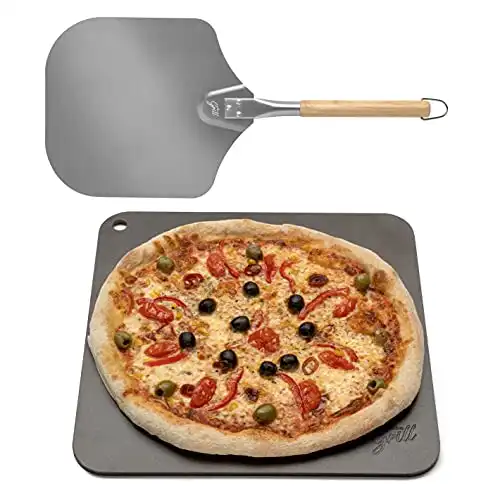
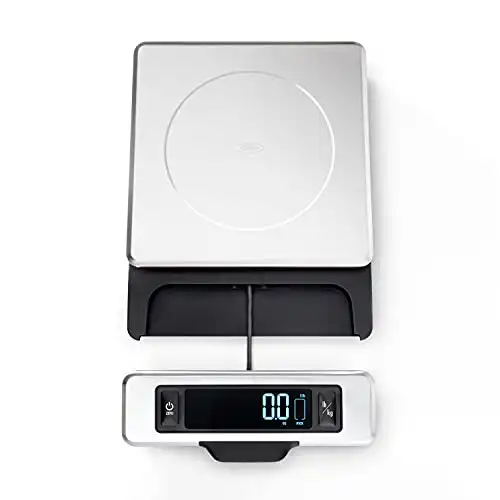
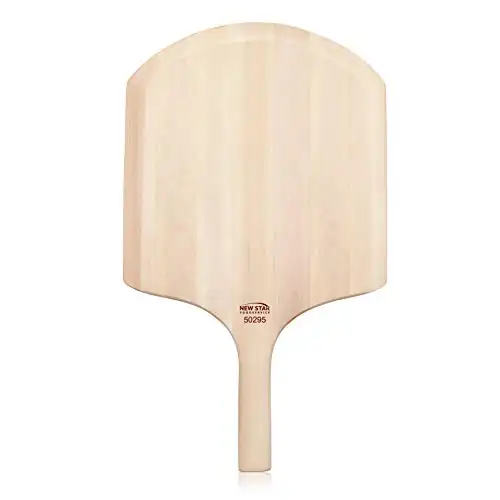
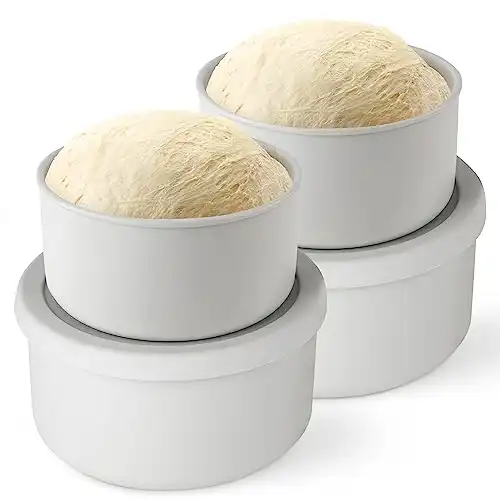
You call for 2 1/4 cups of water….
Warm water?
Cold water?
Room temp is just fine – the dough will go right into the fridge anyway. keep in mind that if you use water that is too hot you could kill the yeast
Room temp works well
Hi, just one thing I just do not get it, in your recipe you put the salt in with the yeast…. yeast goes flat..
why not sugar to start the yeast proofing? and add the salt in the flour and whisk it! you even talk about this
in your tips, but in your steps you put salt in the yeast. I am from ozone park, Queens, n.y.
I bake as to keep my stress level in check, I have P T S D from the miliatry after 28 years… just like baking
lots of different breads, and pizza
I have tried many pizza dough recipes.
This is it!! Best pizza dough ever.
These tips are very helpful too.
What if I don’t have that much time and need to make it tonight? Will it be ok?
I’d try to leave it at room temp until it rises (doubles) and then ball it up and refrigerate until 1 hour or so before needed. but probably won’t get same flavor as the longer fermentation. try both and see what you think
Best pizza dough demonstration ever seen. Thank you so much to the chef.
I’ve been making this dough for months, and last week I tried making it the day of, no refrigeration. It was still very good, and the difference is not hugely apparent.
Interesting Sam! How long did it take to proof? Do you remember what water temp you used?
In the beginning you state that one of the variables is water temperature. The list of ingredients does not say anything about what temperature you should use. Can you please let me know about what temperature you use when making your pizza dough?
I just use room temp water. I know that is confusing but since we are placing dough in the refrigerator right away I don’t feel the water temp matters too much unless it’s so hot that it kills the yeast or causes the dough temp to rise too much. you may need to “bloom” your yeast, depending on the brand you use – I use a brand of yeast that doesn’t require activation
How does this recipe work with 00 flour?
I have never tried it, sorry – I do use the 00 flour for a neopolitan pizza but I think it would work well!
I use 00 flour also I. Don’t use tap water I buy bottled water much better mix yeast water Sugar. Mix salt with flour. Then add wet ingredients I try same day dough But best I’ve made was 5 days old I make 3 balls and eat lots of pizza all week using up the balls as week progresses But yes I’ve Tryed all kinds of different flours. 00 is the best for my taste also easier to stretch. Manga I only use this recipe booked marked in my phone Tryed tons of so called new york recipes. This is the BEST. From a New Yorker.
Is 72 hours after a strict cutoff for this dough. I know some recipes say you can leave in the fridge for up to 2 weeks
Nah definitely not a strict cut-off but I’m not sure I’ve ever had luck waiting quite that long…maybe a week out and it was still good though. I can’t hurt to try though – the worst case, you could make flatbread on the grill since it might not rise as much after baked if it’s 2 weeks old – let use know how it work. But 72 hours is definitley not a strict cut-off just a “sweet spot” according to some folks
I used your recipe exactly and weighed the measurements as you suggested. I cooked one pizza of the four after about 28 hours in the fridge. I figured by baking one at a time after waiting one more day each time I could decide for myself how much better they turn out based on 1,2,3,4 days cold rise. The one day rise that I cooked was delicious so I have no doubt the next ones will be even better. My question is based on something you said. You said if you ever wondered why two identical dough recipes tasted different it’s because the one you liked was cold rise dough. I paraphrased your words there. So I was curious if you really believe that? I have a recipe that I previously used but I let it rise on the counter twice, both times for two hours. Was wondering if I use my old recipe but cold rise instead, would it turn out like yours?
Thanks for the dough recipe, all the tips, it was fantastic and I loved reading the comments.
Hi Jay – well, I must say that I prefer a slow rise, whether it is cold or warm – so the cold temperature can slow down the rise of the dough but you can also accomplish this by using very little yeast in your recipe and letting it rise over many hours (I think the former option is easier for many people). If your dough rose in 2 hours room temp using your former recipe, you might be able to slow that down by placing the dough in the refrigerator. I’m not sure how much yeast is in your other recipe? Slowing the fermentation increases flavor – bread, like wine and cheese is a one of the greatest fermented foods 🙂
Well that’s not really what I was asking so I will rephrase the question. In your discussion and tips you said how different doughs can taste so different and that’s because the good one used a cold rise, even though it’s probably very similar in the recipe, it’s just the cold rise that’s what made it better. My question was if I used my recipe which is slightly different than yours, but did the cold rise instead of the counter top rise, would it really end up just as good as yours?
Hi Jay, that’s hard to say without knowing what your recipe is. It’s be interesting maybe to do a side by side comparison 🙂
Question, you mention water temperature being important but don’t actually Bring up the temperature you use. Is around 110 to 120 Fahrenheit good?
oh gosh, I wouldn’t go that high – you are close to or at the threshold for killing the dry yeast. I’d just use lukewarm water or even room temp
What’s lukewarm? Yeah, I’m sure there’s an around temp for that. Let’s see. As for an exact temperature for lukewarm, there’s no set standard. Some belief lukewarm to be between 98° F and 105° F. Others believe lukewarm might be in the range of 80° F to 90° F. Personally I do 102° F
110°F to active dry yeast. But from what I have read on the “instant Yeast” it states to have your liquids 120°F-130°F. So what is it? Why would a company put something on the package that didn’t work? Wait let’s talk yeast. Cause if you’re not going by the instructions then you can’t complain about a product. So as a seller if I put a product out that doesn’t work per my directions then I’m losing money cause no one is going to buy again. So are they wrong stating 120°F-130°F for instant Yeast. And yes anything over 110°F will kill your dry active yeast. But room temp is not doing the job either in helping it bloom. So how about make temps so people don’t have to guess. These temperatures are inconsistent and never the same. Can affect the outcome of food.
Just my humble opinion that the majority of people aren’t using kitchen thermometers to test water temp and so manufacturers are trying to make it easy. I hear your frustration though…keep it safe and use room temp water. My yeast is very vigorous (Red Star/SAF) and doesn’t need warm water to bloom – all brands are different though so best to check the instructions since this varies by brand.
Question, I usually make dough that gets left out and doubles in size after about 90 minutes. I made your recipe last night around 8pm and put it right in the fridge. It’s 9am now I just checked and it still looks pretty much the same size. I know you said with being in the fridge it will be a slow process. But should or have grown by now?
I only have active dry yeast but Ive made dough plenty of times before without issue.
Help would be nice? Thank you 🙂
Oh just saw this, sorry! The dough will normal show some kind of bubbling activity on bottom of container. Growth isn’t always very obvious – how did it turn out?
Can I add italian seasoning to the dough? What would be the best step to incorporate it?
Sure you can although I’ve never tried it. Personally I’d knead it in after the dough comes together. And I’d start out with a less is more approach
Can I use this dough to make calzones?
absolutely!
Ive made this literally dozens of times and it’s DELISH!
I make the four, let them set in the fridge three days, and then freeze what I’m not using immediately. Never a problem. Ever!
Living in Mexico, im starved for good pizza. It’s just not their thing in my town and the pizzas are horrible!
Thank you!
Looks like a great recipe, thank you. How do you get the frozen dough ready to use?
I just take it out of the freezer the morning I want pizza for dinner; after defrosted, set it on the countertop to warm it up for about 30 to 60 minutes depending on room temp.
Hello,
There is one thing I would like to know and that is should I proof my dough before I freeze it or can I freeze it after I mix it . Thank you in advance for your help.
yes – proof it first, and then cut it into 4 pieces, form balls and freeze